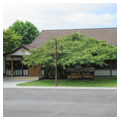You are here
White River Buddhist Temple
The White River Buddhist Temple is the home of the second oldest Buddhist congregation in the Pacific Northwest. The congregation’s current home is one of several religious structures designed by A.K. Arai, the first Japanese-American native of Washington state to design buildings under his own name. The temple, completed in 1964, exemplifies Arai’s ability to meld modern and Asian design influences into a striking example of rationalized, expressed structure in the wall construction. The roof over the sanctuary, meanwhile, maintains the flavor of the traditional Japanese irimoya roof—a roof form incorporating hips at the eaves and gables at the ridge peak. Arai used this roof structure on all his Buddhist religious structures, although the exposed wood and stucco wall panels suggesting an architectural modernism finds its clearest expression in Arai’s work at White River.
The White River Buddhist Temple stands in a clearing in the suburban city of Auburn, Washington, some 19 miles southeast of Seattle. The building is located along 37th Avenue Northeast near its intersection with busy Auburn Way North in a light industrial area characterized today by car dealerships, warehouses, storage units, auto parts stores—an unassuming location for a temple. The building’s main entrance faces towards Auburn Way North, but is set behind trees and a parking lot and not clearly visible from the road. Beyond changes to its context over the past half century, however, the building itself remains mostly in its original condition.
In 2011–2012, however, the congregation altered the main entrance to improve accessibility. As part of this alteration, the original flat-roofed porch was replaced with the present pitched-roof porch and its Buddhist lotus symbol in the gable. In addition, the original wood shake roof was replaced with tile roofing. Although the new porch is more closely related to traditional Japanese architecture than the earlier porch, the building overall still suggests a blending of both the modern and the traditional.
Arai’s work at Auburn and, indeed, his entire architectural output (which includes only a small number of buildings spread over a 35-year period), remains widely overlooked. Arai was born in Port Blakely on August 30, 1901 to first-generation Japanese parents, and his notoriety as a designer may have proceeded differently had it not been for his nationality. While studying architecture at the University of Washington, he changed his name from Kichio Allen Arai to K. Allen Arai and eventually to A.K. Arai. He would become known within the local Japanese-American community as the talented left-handed pitcher “Anki” Arai for the Nippon Athletic Club (a local semi-professional baseball team) as well as its most prominent pre–World War II architect. Outside of the Japanese-American community, however, and despite academic success that included a baccalaureate degree from the University of Washington in 1925 and a Master of Architecture from Harvard University in 1930, racial prejudice haunted his personal and professional career.
Arai’s talent is, however, without question. Trained in the Beaux-Arts tradition at the University of Washington, Arai was nonetheless adept at designing in a variety of styles, and several surviving drawings from his student years have demonstrated his extraordinary rendering abilities (many have been reproduced and can be regularly discovered for sale as prints). He never did obtain his architectural license, which is why several buildings—including the White River Buddhist Temple—have other architects listed as those of “record,” even if Arai did much of the design work. Completion of his Betsuin Buddhist Temple in Seattle (1940–1941) was followed by his incarceration—along with that of virtually the entire local Japanese-American community—in an internment camp located at Minidoka, Idaho. Arai’s professional career never fully recovered, but local Japanese-American Buddhists never forgot Arai’s talent, resulting in postwar temples by Arai in Ontario, Oregon, as well as that in Auburn.
References
MacIntosh, Heather A. “Arai, Kichio Allen (1901-1966), Architect.” Essay 139. HistoryLink.org: The Free Online Encyclopedia of Washington State History, November 3, 1998. Accessed September 24, 2017. www.historylink.org.
Rash, David A. “Kichio Allen Arai.” In Shaping Seattle Architecture: A Historical Guide to the Architects,edited by Jeffrey Ochsner, 284-289. 2nd ed. Seattle: University of Washington Press, 2014.
“White River Buddhist Temple, Auburn, Washington.” Buddhist Churches of America: 75-Year History, 1899-1974. Chicago: Norbart, Inc., 1974.
Writing Credits
If SAH Archipedia has been useful to you, please consider supporting it.
SAH Archipedia tells the story of the United States through its buildings, landscapes, and cities. This freely available resource empowers the public with authoritative knowledge that deepens their understanding and appreciation of the built environment. But the Society of Architectural Historians, which created SAH Archipedia with University of Virginia Press, needs your support to maintain the high-caliber research, writing, photography, cartography, editing, design, and programming that make SAH Archipedia a trusted online resource available to all who value the history of place, heritage tourism, and learning.

















